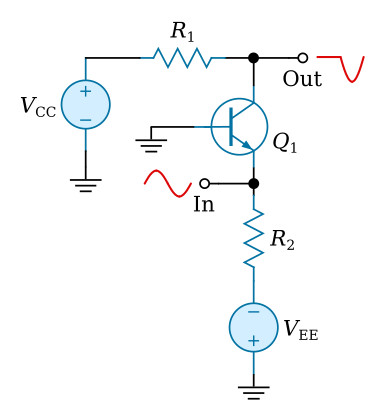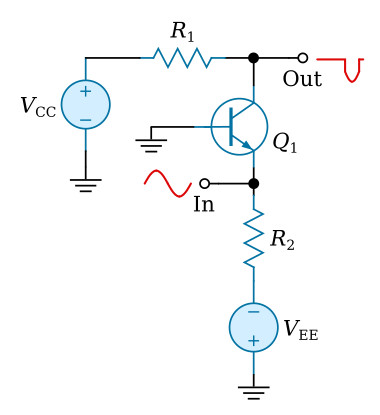Home > Textbooks > Basic Electronics > Amplifiers > Amplifier Classes of Operation >
Amplifiers
Amplifier Classes of Operation
A bipolar transistor amplifier is a current-control device. The current in the base of the transistor (which is dependent on the emitter-base bias) controls the current in the collector. This section will use transistor amplifiers to present the concepts and principles of amplifiers. The first amplifier concept that is discussed is the "class of operation" of an amplifier.
The class of operation of an amplifier is determined by the amount of time (in relation to the input signal) that current flows in the output circuit. This is a function of the operating point of the amplifying device. The operating point of the amplifying device is determined by the bias applied to the device. There are four basic classes of operation for an amplifier. These are: A, AB, B and C. Each class of operation has certain uses and characteristics. No one class of operation is "better" than any other class. The selection of the "best" class of operation is determined by the use of the amplifying circuit. The best class of operation for a phonograph is not the best class for a radio transmitter.
Class A Operation
A simple transistor amplifier that is operated class A is shown in the figure below. Since the output signal is a 100% (or 360°) copy of the input signal, current in the output circuit must flow for 100% of the input signal time. This is the definition of a class A amplifier. Amplifier current flows for 100% of the input signal.

The class A amplifier has the characteristics of good fidelity and low efficiency. Fidelity means that the output signal is just like the input signal in all respects except amplitude. It has the same shape and frequency. In some cases, there may be a phase difference between the input and output signal (usually 180°), but the signals are still considered to be "good copies". If the output signal is not like the input signal in shape or frequency, the signal is said to be distorted. Distortion is any undesired change in a signal from input to output.
The efficiency of an amplifier refers to the amount of power delivered to the output compared to the power supplied to the circuit. Since every device takes power to operate, if the amplifier operates for 360° of input signal, it uses more power than if it only operates for 180° of input signal. If the amplifier uses more power, less power is available for the output signal and efficiency is lower. Since class A amplifiers operate (have current flow) for 360° of input signal, they are low in efficiency. This low efficiency is acceptable in class A amplifiers because they are used where efficiency is not as important as fidelity.
Class AB Operation
If the amplifying device is biased in such a way that current flows in the device for about 51% - 99% of the input signal, the amplifier is operating class AB. A simple class AB amplifier is shown in the figure below.

Notice that the output signal is distorted. The output signal no longer has the same shape as the input signal. The portion of the output signal that appears to be cut off is caused by the lack of current through the transistor. When the emitter becomes positive enough, the transistor cannot conduct because the base-to-emitter junction is no longer forward biased. Any further increase in input signal will not cause an increase in output signal voltage.
Class AB amplifiers have better efficiency and poorer fidelity than class A amplifiers. They are used when the output signal need not be a complete reproduction of the input signal, but both positive and negative portions of the input signal must be available at the output.
Class AB amplifiers are usually defined as amplifiers operating between class A and class B because class A amplifiers operate on 100% of input signal and class B amplifiers (discussed next) operate on 50% of the input signal. Any amplifier operating between these two limits is operating class AB.
Class B Operation
As was stated above, a class B amplifier operates for 50% of the input signal. A simple class B amplifier is shown in the figure below.

In the circuit shown in the figure above, the base-emitter bias will not allow the transistor to conduct whenever the input signal becomes positive. Therefore, only the negative portion of the input signal is reproduced in the output signal. You may wonder why a class B amplifier would be used instead of a simple rectifier if only half the input signal is desired in the output. The answer to this is that the rectifier does not amplify. The output signal of a rectifier cannot be higher in amplitude than the input signal. The class B amplifier not only reproduces half the input signal, but amplifies it as well.
Class B amplifiers are twice as efficient as class A amplifiers since the amplifying device only conducts (and uses power) for half of the input signal. A class B amplifier is used in cases where exactly 50% of the input signal must be amplified. If less than 50% of the input signal is needed, a class C amplifier is used.
Class C Operation
The figure below shows a simple class C amplifier. Notice that only a small portion of the input signal is present in the output signal. Since the transistor does not conduct except during a small portion of the input signal, this is the most efficient amplifier. It also has the worst fidelity. The output signal bears very little resemblance to the input signal.

Class C amplifiers are used where the output signal need only be present during part of one-half of the input signal. Any amplifier that operates on less than 50% of the input signal is operated class C.






